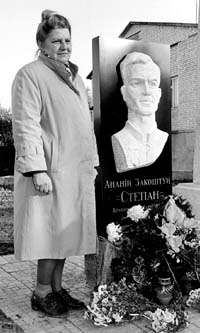Return to one’ s native village as a monument

The week before last saw the unveiling of a monument to oblast OUN leader Anany Zakoshtui in the village of Lavriv in Volyn. I had heard about him since I was a little girl. Every time people gathered at a party, recalling the past, they always mentioned his name. They said he was “a nationalist from his childhood,” “loved Ukraine,” and organized spectacular Mother’s Days and Shevchenko Days for his fellow villagers. They called him a “conscious politician” and “honest Ukrainian.” Even inveterate Communists (of whom there were few in our village known as Bandera one) acknowledged him a leader of Ukrainian patriots. Anany Zakoshtui was highly educated having graduated from the Lutsk gymnasium and spoke five languages.
In 1940 the Zakoshtui family was among the first sent to Siberia and Kazakhstan. Anany was rescued by his fellow villagers, guards, who took him to Lutsk for interrogation and helped him escape on the way. He returned to Lavriv when the Germans invaded. My mother Liubov Pylypivna was in the church when at the end of the service the churchwarden asked people to stay, because “Zakoshtui will speak.” He said, “Ukraine will be but not soon. We will have to fight for it.” He also asked the villagers to refrain from murder, because this is a sin, and to fight for Ukraine in peaceful ways if possible.
History is a strange (or just) matter. During one generation’s life many regimes changed, and finally, perhaps, the right one has been established. In the center of Lavriv near the village council building there is an obelisk to those killed in the Great Patriotic War on one side, and a monument to the fighters for Ukraine’s freedom and independence and a high relief to Anany Zakoshtui on the other. The latter was erected by the initiative of village council head Arsen Sydorchuk and executed by sculptor Iryna Datsiuk, who in her speech at the meeting confessed that she worked on Zakoshtui’s image with great interest. This was a chance for her to learn one more page of Ukraine’s history and try to understand those he belonged to and what they fought for: for the life in their country, for working for themselves, for their own church... Zakoshtui looks from his obelisk at the newly built Lavriv church, burnt down by the Germans, prohibited by the Communists, and recently restored on its old site. Even before the opening ceremony was held, a newly married couple came here directly from church, and the next day came another. In fact, this was an event for the whole village, which had knows better times and gone through many ordeals. On one monument the names of the twenty-two Lavriv residents killed in the Lutsk prison in June 1941 are inscribed. On the other one are dozens of names of OUN-UPA members, and this list is far from complete.
Zakoshtui’s daughter Uliana, who never bore his surname, came to her father’s native village from Lviv for the first time. With agitation she told how her father in 1944 warned his wife, Ivanna from Galicia, who was a schoolteacher in Lavriv, to escape from the village and take care of their future child and how her mother waited for him for her whole life. She still does. Uliana always knew whose daughter she was, and the authorities knew so as well.
It is still unknown where conscious politician and honest Ukrainian Anany Zakoshtui, one of the leaders of the national liberation movement in Western Ukraine, died. His trace is lost somewhere in early 1950s.






